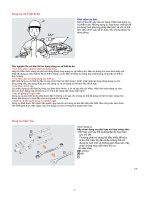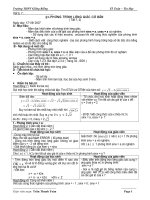chương 1 lập trình mạng khái niệm cơ bản các giao thức và thuật ngữ
Bạn đang xem bản rút gọn của tài liệu. Xem và tải ngay bản đầy đủ của tài liệu tại đây (230.3 KB, 11 trang )
1/2/2020
Chapter 1
Basic concept, Protocols and terminology
Contents
• Clients, servers and peers
• Ports and sockets
• The Internet and IP addresses
• Internet services, URLs and DNS
• TCP
• UDP
1.1 Clients, servers and peers
• The most common categories of network software nowadays are
clients and servers.
• These two categories have a symbiotic relationship and the term
client/server programming has become very widely used in recent
years.
• It is important to distinguish firstly between a server and the machine
upon which the server is running (called the host machine), since I.T.
workers often refer loosely to the host machine as ‘the server’.
1
1/2/2020
1.1 Clients, servers and peers
• A server, as the name implies, provides a service of some kind.
• This service is provided for clients that connect to the server’s host
machine specifically for the purpose of accessing the service.
• Thus, it is the clients that initiate a dialogue with the server. (These
clients, of course, are also programs and are not human clients!)
1.1 Clients, servers and peers
• Common services provided by such servers include the ‘serving up’ of
Web pages (by Web servers) and the downloading of files from
servers’ host machines via the File Transfer Protocol (FTP servers).
• For the former service, the corresponding client programs would be
Web browsers (such as Firefox, Chrome or Microsoft Edge). For the
later one, the client program can be FileZilla Client.
1.1 Clients, servers and peers
• Though a client and its corresponding server will normally run on
different machines in a real-world application, it is perfectly possible
for such programs to run on the same machine.
• Indeed, it is often very convenient (as will be seen in subsequent
chapters) for server and client(s) to be run on the same machine,
since this provides a very convenient ‘sandbox’ within which such
applications may be tested before being released (or, more likely,
before final testing on separate machines).
• This avoids the need for multiple machines and multiple testing
personnel.
2
1/2/2020
1.1 Clients, servers and peers
• In some applications, such as messaging services, it is possible for programs on
users’ machines to communicate directly with each other in what is called peertopeer (or P2P) mode.
• However, for many applications, this is either not possible or prohibitively costly
in terms of the number of simultaneous connections required.
• For example, the World Wide Web simply does not allow clients to communicate
directly with each other. However, some applications use a server as an
intermediary, in order to provide ‘simulated’peer-to-peer facilities.
• Alternatively, both ends of the dialogue may act as both client and server. Peerto-peer systems are beyond the intended scope of this text, though, and no
further mention will be made of them.
1.2 Ports and sockets
• These entities lie at the heart of network communications.
• For anybody not already familiar with the use of these terms in a
network programming context, the two words very probably conjure
up images of hardware components.
• However, although they are closely associated with the hardware
communication links between computers within a network, ports and
sockets are not themselves hardware elements, but abstract concepts
that allow the programmer to make use of those communication
links.
1.2 Ports and sockets
• A port is a logical connection to a computer (as opposed to a physical
connection) and is identified by a number in the range 1–65535.
• This number has no correspondence with the number of physical
connections to the computer, of which there may be only one (even though
the number of ports used on that machine may be much greater than this).
• Ports are implemented upon all computers attached to a network, but it is
only those machines that have server programs running on them for which
the network programmer will refer explicitly to port numbers.
3
1/2/2020
1.2 Ports and sockets
• Each port may be dedicated to a particular server/service (though the
number of available ports will normally greatly exceed the number that is
actually used).
• Port numbers in the range 1–1023 are normally set aside for the use of
specified standard services, often referred to as ‘well-known’ services.
• For example, port 80 is normally used by Web servers. Some of the more
common well-known services are listed in Sect. 1.4.
• Application programs wishing to use ports for non-standard services should
avoid using port numbers 1–1023. (A range of 1024–65535 should be more
than enough for even the most prolific of network programmers!).
1.2 Ports and sockets
• For each port supplying a service, there is a server program waiting
for any requests.
• All such programs run together in parallel on the host machine.
• When a client attempts to make connection with a particular server
program, it supplies the port number of the associated service. The
host machine examines the port number and passes the client’s
transmission to the appropriate server program for processing.
1.2 Ports and sockets
• In most applications, of course, there are likely to be multiple clients
wanting the same service at the same time.
• A common example of this requirement is that of multiple browsers
(quite possibly thousands of them) wanting Web pages from the
same server.
The server, of course, needs some way of distinguishing between
clients and keeping their dialogues separate from each other. This is
achieved via the use of sockets.
4
1/2/2020
1.2 Ports and sockets
• As stated earlier, a socket is an abstract concept and not an element of
computer hardware.
• It is used to indicate one of the two end-points of a communication link
between two processes.
• When a client wishes to make connection to a server, it will create a socket at its end
of the communication link.
• Upon receiving the client’s initial request (on a particular port number), the server
will create a new socket at its end that will be dedicated to communication with that
particular client.
• Just as one hardware link to a server may be associated with many ports,
so too may one port be associated with many sockets.
1.3 The Internet and IP addresses
• An internet (lower-case ‘i’) is a collection of computer networks that
allows any computer on any of the associated networks to
communicate with any other computer located on any of the other
associated networks (or on the same network, of course).
• The Internet (upper-case ‘I’) is the world’s largest IP-based network.
• Each computer on the Internet has a unique IP address, the current
version of which is still, for most people, IPv4 (Internet Protocol
version 4), though this is likely to change at some point during the
next few years.
1.3 The Internet and IP addresses
• This represents machine addresses in what is called quad notation. This is
made up of four eight-bit numbers (i.e., numbers in the decimal range 0–
255), separated by dots.
• For example, 131.122.3.219 would be one such address.
• Due to a growing shortage of IPv4 addresses, IPv4 is due to be replaced
with IPv6, the draft standard for which was published on the 10th of
August, 1998.
• IPv6 uses 128-bit addresses, which provide massively more addresses.
Many common Internet applications already work with IPv6 and it is
expected that IPv6 will gradually replace IPv4, with the two coexisting for a
number of years during a transition period.
5
1/2/2020
1.4 Internet services, URLs and DNS
• Whatever the service provided by a server, there must be some
established protocol governing the communication that takes place
between server and client.
• Each end of the dialogue must know what may/must be sent to the
other, the format in which it should be sent, the sequence in which it
must be sent (if sequence matters) and, for ‘open-ended’ dialogues,
how the dialogue is to be terminated.
• For the standard services, such protocols are made available in public
documents, usually by either the Internet Engineering Task Force
(IETF) or the World Wide Web Consortium (W3C).
1.4 Internet services, URLs and DNS
1.4 Internet services, URLs and DNS
• A URL (Uniform Resource Locator) is a unique identifier for any
resource located on the Internet. It has the following structure
• For example:
/>
•
6
1/2/2020
1.4 Internet services, URLs and DNS
• For a well-known protocol, the port number may be omitted and the
default port number will be assumed.
• Thus, since the example above specifies the HTTP protocol (the protocol of the Web)
and does not specify on which port of the host machine the service is available, it
will be assumed that the service is running on port 80 (the default port for Web
servers).
• If the file name is omitted, then the server sends a default file from the
directory specified in the path name. (This default file will commonly be
called index.html or default.html.)
• The ‘section’ part of the URL (not often specified) indicates a named
‘anchor’ in an HTML document. For example, the HTML anchor in the tag
<A HREF="#summary">Summary of Report</A>
would be referred to as summary by the section component of the URL.
1.4 Internet services, URLs and DNS
• Since human beings are generally much better at remembering
meaningful
strings of characters than they are at remembering long strings of
numbers, the Domain Name System was developed.
• A domain name, also known as a host name, is the user-friendly
equivalent of an IP address.
• In the previous example of a URL, the domain name was
www.oracle.com.
1.4 Internet services, URLs and DNS
• Normally, human beings will use domain names in preference to IP
addresses, but they can just as well use the corresponding IP addresses (if
they know what they are!).
• The Domain Name System provides a mapping between IP addresses and
domain names and is held in a distributed database.
• The IP address system and the DNS are governed by ICANN (the Internet
Corporation for Assigned Names and Numbers), which is a
nonprofitmaking organization.
• When a URL is submitted to a browser, the DNS automatically converts the
domain name part into its numeric IP
equivalent.
7
1/2/2020
1.5 TCP
• In common with all modern computer networks, the Internet is a packetswitched network, which means that messages between computers on the
Internet are broken up into blocks of information called packets, with each
packet being handled separately and possibly travelling by a completely
different route from that of other such packets from the same message.
• IP is concerned with the routing of these packets through an internet.
• Introduced by the American military during the Cold War, it was designed
from the outset to be robust.
• In the event of a military strike against one of the network routers, the rest of the
network had to continue to function as normal, with messages that would have gone
through the damaged router being rerouted. IP is responsible for this re-routing. It
attaches the
• IP address of the intended recipient to each packet and then tries to determine the
most efficient route available to get to the ultimate destination (taking damaged
routers into account)
1.5 TCP
• However, since packets could still arrive out of sequence, be corrupted or
even not arrive at all (without indication to either sender or intended
recipient that anything had gone wrong), it was decided to place another
protocol layer on top of IP.
• This further layer was provided by TCP (Transmission Control Protocol),
which allowed each end of a connection to acknowledge receipt of IP
packets and/or request retransmission of lost or corrupted packets.
• In addition, TCP allows the packets to be rearranged into their correct
sequence at the receiving end.
• IP and TCP are the two commonest protocols used on the Internet and are
almost invariably coupled together as TCP/IP. TCP is the higher level
protocol that uses the lower level IP.
1.5 TCP
• For Internet applications, a four-layer model is often used, which is
represented diagrammatically in figure below.
• The transport layer will often comprise the TCP protocol, but may be
UDP (described in the next section), while the internet layer will
always be IP.
8
1/2/2020
1.5 TCP
• Each layer of the model represents a different level of abstraction,
with higher levels representing higher abstraction.
• Thus, although applications may appear to be communicating directly
with each other, they are actually communicating directly only with
their transport layers. The transport and internet layers, in their turn,
communicate directly only with the layers immediately above and
below them, while the host-to-network layer communicates directly
only with the IP layer at each end of the connection.
1.5 TCP
• When a message is sent by the application layer at one end of the
connection, it passes through each of the lower layers. As it does so,
each layer adds further protocol data specific to the particular
protocol at that level.
• For the TCP layer, this process involves breaking up the data packets into TCP
segments and adding sequence numbers and checksums;
• For the IP layer, it involves placing the TCP segments into IP packets called
datagrams and adding the routing details.
• The host-to-network layer then converts the digital data into an analogue
form suitable for transmission over the carrier wire, sends the data and
converts it back into digital form at the receiving end.
1.5 TCP
• At the receiving end, the message travels up through the layers until it
reaches the receiving application layer.
• As it does so, each layer converts the message into a form suitable for
receipt by the next layer (effectively reversing the corresponding
process carried out at the sending end) and carries out checks
appropriate to its own protocol
9
1/2/2020
1.5 TCP
• If recalculation of checksums reveals that some of the data has been
corrupted or checking of sequence numbers shows that some data
has not been received, then the transport layer requests retransmission of the corrupt/missing data.
• Otherwise, the transport layer acknowledges receipt of the packets.
All of this is completely transparent to the application layer.
• Once all the data has been received, converted and correctly
sequenced, it is presented to the recipient application layer as though
that layer had been in direct communication with the sending
application layer.
1.5 TCP
• The above description has deliberately hidden many of the low-level
details of implementation, particularly the tasks carried out by the
host-to-network layer.
• In addition, of course, the initial transmission may have passed
through several routers and their associated layers before arriving at
its ultimate destination.
• However, this high-level view covers the basic stages that are involved
and is quite sufficient for our purposes.
1.6 UDP
• In contrast to TCP, User Datagram Protocol (UDP) is an unreliable
protocol, since:
• it doesn’t guarantee that each packet of data will arrive;
• it doesn’t guarantee that packets will be in the right order
• UDP doesn’t re-send a packet if it fails to arrive or there is some other
error and it doesn’t re-assemble packets into the correct sequence at
the receiving end.
• However, the TCP overhead of providing facilities such as
confirmation of receipt and re-transmission of lost or corrupted
packets used to mean that UDP was significantly faster than TCP.
10
1/2/2020
1.6 UDP
• As far as these applications were concerned, it was much more important
that the data arrived intact and in the correct sequence, both of which
were guaranteed by TCP.
• For some applications, however, the relatively slow throughput speed
offered by TCP was simply not feasible. Such applications included the
streaming of audio and video files (i.e., the playing of those files while
they were being downloaded).
• Such applications didn’t use TCP, because of its large overhead. Instead,
they used UDP, since their major objective was to keep playing the
sound/video without interruption and losing a few bytes of data was much
better than waiting for re-transmission of the missing data.
1.6 UDP
• Nowadays, network transmission speeds are considerably greater
than they were only a few years ago, meaning that TCP is now a
feasible transport mechanism for applications in which it would not
once have been considered.
• In addition to this, it is much easier for TCP packets to get through
firewalls than it is for UDP packets to do so, since Web administrators
tend to allow TCP packets from remote port 80s to pass through
unchallenged.
• For these reasons, the choice of whether to use TCP or UDP for
speed-critical applications is not nearly as clear cut as it used to be.
11









